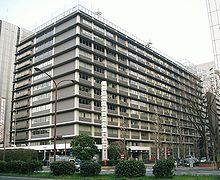Native name | 日本郵政公社 |
|---|---|
Romanized name | Nippon Yūsei Kōsha |
| Company type | Statutory corporation |
| Industry | Courier |
| Predecessor | Postal Services Agency of the Ministry of Public Management, Home Affairs, Posts and Telecommunications |
| Founded | 1 April 2003, by reorganization of the Postal Services Agency |
| Defunct | 1 October 2007 |
| Fate | Privatized |
| Successor | Japan Post Holdings |
| Headquarters | , Japan |
Key people | Maejima Hisoka |
| Revenue | |
Number of employees | 256,572 (full-time, 2006) |
| Divisions | Postal Service, Postal Savings, Postal Life Insurance |

Japan Post (日本郵政公社, Nippon Yūsei Kōsha) was a Japanese statutory corporation that existed from 2003 to 2007, offering postal and package delivery services, banking services, and life insurance. It is the nation's largest employer, with over 400,000 employees, and runs 24,700 post offices throughout Japan. One third of all Japanese government employees work for Japan Post. As of 2005, the President of the company was Masaharu Ikuta, formerly Chairman of Mitsui O.S.K. Lines Ltd.
Japan Post ran the world's largest postal savings system and is often said to be the largest holder of personal savings in the world: with ¥224 trillion ($2.1 trillion) of household assets in its yū-cho savings accounts, and ¥126 trillion ($1.2 trillion) of household assets in its kampo life insurance services; its holdings account for 25 percent of household assets in Japan. Japan Post also holds about ¥140 trillion (one fifth) of the Japanese national debt in the form of government bonds.
On October 1, 2007, Japan Post was privatized following a fierce political debate that was settled by the general election of 2005.[1] The major concern was Japan Post, with government backing, stymieing competition and giving politicians access to postal savings to fund pet projects.[2] Japan post was split into three companies in 2007, intending to be privatized by 2017.[2] Following privatization, Japan Post Holdings operate the postal business.
In 2010, the privatization was put on hold, with the Japanese Ministry of Finance remaining the 100% shareholder. However, on October 26, 2012, the Japanese government unveiled plans to list shares of Japan Post Holdings within three years, partly to raise money for the reconstruction of areas devastated by the earthquake and tsunami of 2011.[3] As of 2020, the government still holds 57% of shares, and March 2028 was announced as the target date of privatization.[2] In October 2021, the Japanese government completed its majority privatisation process of Japan Post Holdings, but also still maintained control of most of the company's stock.[4][5]
- ^ Maclachlan, Patricia L. (2024). "Mechanisms of Resistance: Informal Institutional Impediments to Japanese Postal Privatization". Comparative Politics. doi:10.5129/001041524x17292553869970.
- ^ a b c "Japan Post's zombie privatization is warning to Shinzo Abe". Nikkei Asian Review. Retrieved 2020-07-16.
- ^ "Japan govt aims to list Japan Post in three years". Reuters. October 26, 2012.
- ^ "Japan to sell 27% of Japan Post to raise reconstruction funds". The Japan Times. Reuters. October 21, 2021. Retrieved December 11, 2021.
- ^ Lewis, Leo; Inagaki, Kana (2021-10-06). "Japan Post pushes ahead with $9bn share sale". Financial Times. Archived from the original on 2022-12-10. Retrieved 2021-12-08.